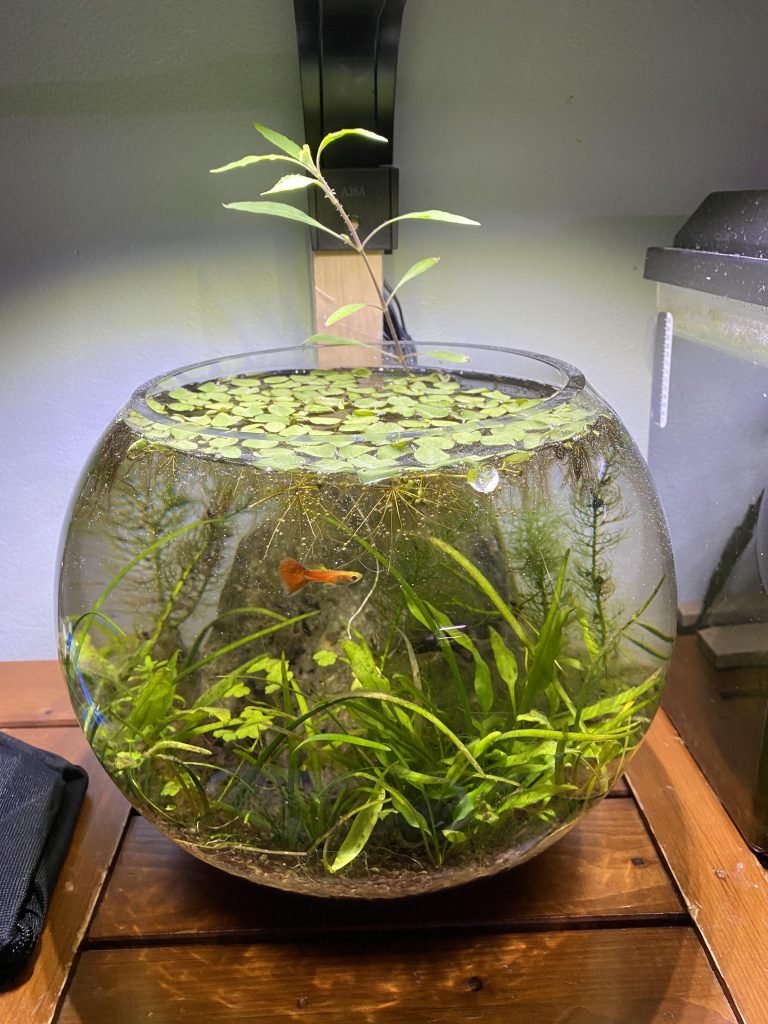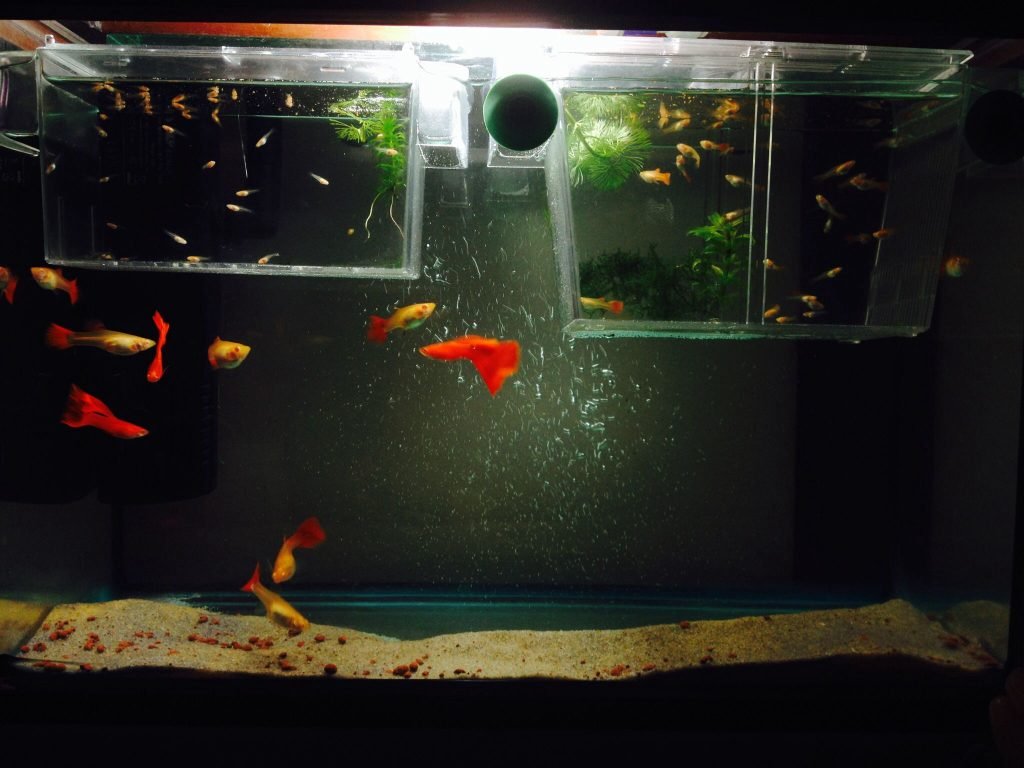Guppy Fry Care
So your guppy gave birth recently, And now you have a full tank.
That means that now you need to figure out how to care for your new additions.
Well, in this guppy fry care guide we will take you from confused on the way to super parent.
Guppy Fry Care
Guppy fry care is pretty straightforward- give them food and the right water conditions and they’ll be happy. You do need to feed them more often and the same goes for water changes.
Feed them about 5 times a day and change their water every 3-5 days.
Before Birth
If this is your first time breeding guppies, allow me to run you through some quick facts:
- Guppies are livebearers, meaning they give birth to live young instead of laying eggs.
- They are prolific breeders, which means they give birth to multiple offspring In a single birth cycle.
- The breeding cycle begins with the male displaying courtship behavior, such as chasing and displaying his vibrant colors to attract the female. (You’ll be able to see the males chase the females pretty persistently around the tank.)
- Once the female is ready to mate, she will allow the male to approach and fertilize her eggs internally.
- Once mated, a female guppy will be able to become pregnant up to 9 times more before needing to mate again.
In simpler words, guppies are water bunnies on steroids.
What To Expect While Expecting
The gestation period (i.e. length of pregnancy) of guppies is typically around 21 to 30 days, depending on the water temperature and the health of the female.
At this time, the female’s abdomen will gradually enlarge as the fry develops inside her.
If your guppy has been hiding, became less social overall, became bigger and her gravid spot became darker- this is a good sign she is pregnant. Her eating habits shouldn’t really change during this time.
Guppy Fry Care: Giving Birth
Guppies will wait for the “perfect” water conditions to give birth.
In other words, a female is perfectly capable of waiting until the time is right. Not that this policy benefits her health- quite the opposite. But she’ll continue to get bigger if the water parameters aren’t right.
How to encourage guppy birth
To encourage your guppy to drop, it’s best to transfer her into a different tank.
What I usually do is place her in an old fish bowl I have laying around. While guppies can’t live in a bowl long term, they are fine for birthing.
You do need a second adjustable heater. Set the water 2 degrees higher than you normally do. I have my tanks at 78 for tropical fish, so I would set the birthing tank at 8.
I would also mix a teaspoon of Epson salt to encourage the female to drop
Transformation
Over the course of several weeks, the fry will undergo significant growth and development.
At around four weeks, their colors and patterns will start to emerge, and they will begin to resemble miniature versions of adult guppies.
It’s vital you provide a well-balanced diet of high-quality fry food and crushed flakes to ensure their healthy growth.
Guppy Fry Care: Post Natal
I’m going to start with a prerequisite- I’m assuming you plan on keeping the fry.
This sounds wild considering this is a guppy fry care guide, but the reason I bring this up is guppies reproduce quickly, and a lot.
What I’m essentially getting at is- in a matter of a few short months you’ll have A LOT of guppies. Unless you plan on using them as feeder fish or selling them- you may not have room for all of them.
The Perfect Setup For Guppy Fry Tank

When setting up a tank for newly born fry, there are a few key considerations.
First, provide ample hiding places such as floating plants or fine-leaved vegetation to offer protection for the fry.
Then, your best bet is just to set up a secondary tank with a filter and heater. Fry are extremely sensitive to water quality and parameters, and the easiest way to go about this is with a filter and heater.
The second the fry drops they are considered a pair game. Adults can’t tell the difference between them and brine shrimp and will most likely try to eat them.
If this is not an option, you can get a cheapo breeding box that will isolate the fry from the adults.

Water Quality
Maintaining the right water quality is paramount for your newborn fish to grow healthy.
Here’s what those parameters should look like:
- Ammonia: 0
- Nitrite: 0
- Nitrate: below 20ppm
- Temp: 78-82
- pH: 7-8
If you want to make your guppy fry grow faster, then you’ll need to change the water every 3 days or so.
If growth rate isn’t an issue, just make sure to test the water as needed.
Why Your Guppy Fry Isn't Eating
Your fry might not want to eat the second they are born. I don’t know what goes on in their heads, but I’m sure there’s plenty that food isn’t their first priority.
Like every other fishkeeper out there, I freaked out when they wouldn’t feed the second they were born.
Fry are born in a yolk that serves as their food source for their first moments in the water. Once they are out of yolk, they’ll gladly accept your alternatives.
You may have heard about feeding guppy fry cooked egg yolks in their first days. While you’re welcome to do that, you don’t have to. They’ll eat other stuff and yolk always makes a huge mess no matter how careful you are with it.
Lighting Schedule
As far as lighting goes, provide a consistent light schedule of around 10-12 hours of light per day for guppy fry.
A regular day-night cycle helps establish their natural rhythm and promotes normal behavior.
You can use a timer to automate the lighting schedule, ensuring consistent and appropriate lighting conditions for their well-being.
Guppy Fry Care: Sample Schedule
Here’s an example of a daily feeding schedule for guppy fry:
Morning
Newly hatched baby brine shrimp or finely powdered commercial fry food. Feed small amounts to ensure they consume it within a few minutes.
Mid- Morning
A mixture of crushed flakes or finely crushed pellets. This helps introduce solid foods and promotes their transition to a varied diet.
Afternoon
Finely powdered or crushed commercial fry food. This provides a balanced nutritional source for their growth and development.
Mid- Afternoon
Freshly hatched baby brine shrimp or micro worms. These live foods are highly nutritious and encourage natural feeding behaviors.
Evening
Repeat the feeding of powdered or crushed commercial fry food. Ensure the portion size is appropriate for their age and size.
It’s important you observe the fry’s feeding response and adjust the portion sizes accordingly to avoid overfeeding. As they grow, you can gradually incorporate more solid foods into their diet.
Guppy Fry Care: Complications
There are a couple of things that can go sideways as part of your guppy fry care journey. Some you can control, and some you can’t.
Here’s a couple of pointers that can take your fry on the wrong road:
Cannibalism
Adult guppies have been known to eat fry guppies, especially immediately after birth.
This behavior is natural and can be attributed to their instinctual drive to consume small, vulnerable organisms.
To minimize the chances of fry being eaten, you need to provide ample hiding places, such as dense vegetation or breeding traps, where fry can seek refuge and grow safely without direct access by adult guppies.
Additionally, separating adult guppies from the fry or moving the fry to a separate nursery tank can help ensure their survival and increase their chances of reaching maturity.
Poor Water Quality
Maintaining good water quality is crucial for the health and well-being of guppy fry.
Clean and well-filtered water provides them with optimal conditions for growth, development, and disease prevention.
Proper water quality also ensures that the fry can breathe easily, absorb nutrients efficiently, and maintain a strong immune system.
It’s important- you get it.
Just make sure to regularly test the water, make sure the filter is working properly, and change the water at least once a week or as needed. That will allow your guppies to grow big and strong and reduce complications.
Birth Difficulties
Birth difficulties usually occur when the female is inexperienced, stressed, or lacks proper nutrition.
It can lead to complications such as prolonged labor, difficulty expelling fry, or even mortality for both the mother and the offspring.
Provide her with a stress-free environment, feed her well, and closely monitor her pregnancy and you’ll minimize the risk of birth difficulties dramatically
if you do notice that your guppy is struggling to give birth you will need to to act pretty quickly. in some cases, you might need to gently massage and assist her with expelling the fry.
In other cases, you may need to seek veterinary advice.
Genetic Issues
Lastly, guppy fry can potentially experience genetic issues due to inbreeding or improper breeding practices.
These issues can manifest as deformities, weak immune systems, reduced fertility, or other genetic abnormalities.
To minimize this risk, it’s important to maintain genetic diversity by introducing unrelated guppies into the breeding population and avoiding repeated breeding between close relatives.
Breeding responsibly is a big part of fry breeding. if you notice guppy fried that are born with deformities or genetic issues you may need to pull them off and euthanize them.
You may do so by returning them back to the tank with the adults or using a mixture of essential oils to cut their development short.
Conclusion
Guppy fry isn’t too complicated to take care of. As long as the water conditions are right and food keeps coming- they’ll be ok.
If you’re able to separate them from the adults- you’ve done about half of the hard work. Remember that guppies are pretty resilient fish, and nature never intended for all of the fry to make it.
And now, a quick favor- have you started breeding guppies already, or are you just in the process?
Let me now in the comments below!
